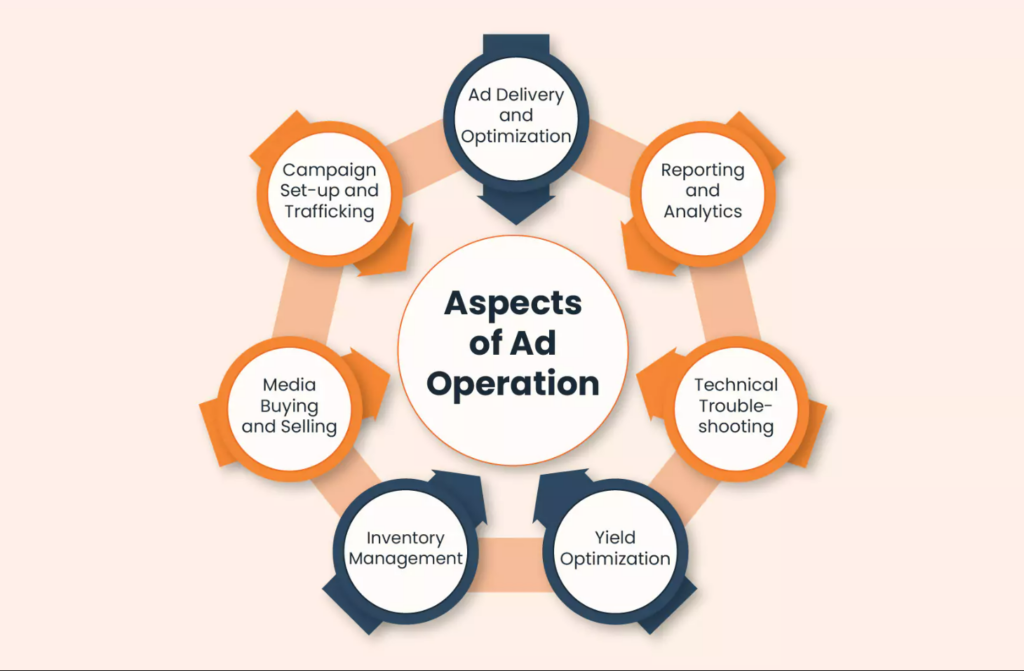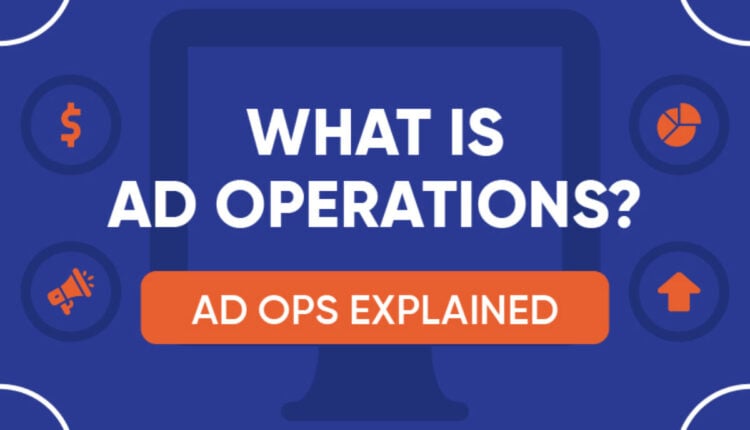In today’s digital age, advertising is the backbone of many online businesses. From websites and mobile apps to social media platforms, advertisements are everywhere. Behind every ad that appears on a website or app is a crucial process known as Ad Operations or Ad Ops. Ad Ops is responsible for the planning, management, and optimization of digital ads, ensuring that advertisers reach their target audience effectively while maximizing revenue for publishers.
If you’re involved in the world of digital advertising, understanding Ad Ops is essential. In this article, we’ll explore what Ad Ops entails, its key functions, and how it contributes to the success of online advertising.
What is Ad Operations (Ad Ops)?
Ad Operations refers to the process of managing and optimizing digital advertising campaigns across different platforms. It encompasses all the technical tasks involved in delivering, tracking, and analyzing online ads, from the moment an ad is created to when it is served to a user.
The main goal of Ad Ops is to ensure that ads are displayed properly, on time, and to the right audience. This involves a combination of strategic planning, technical implementation, and performance analysis. It also includes managing ad inventory, working with ad networks, and ensuring ads meet the required standards and specifications.
Ad Ops teams are usually made up of professionals who work with both advertisers and publishers to ensure smooth execution of campaigns. They often work in collaboration with marketers, sales teams, and other stakeholders in the digital advertising ecosystem.
Key Responsibilities of Ad Ops
Ad Operations professionals handle a wide range of tasks related to digital advertising. Below are some of the main responsibilities:
1. Campaign Management
Managing ad campaigns is one of the core responsibilities of Ad Ops. This involves setting up campaigns in ad servers, selecting targeting options, and ensuring that the right ads are displayed at the right time. Ad Ops teams must make sure that all aspects of the campaign are aligned with the advertiser’s objectives, such as targeting specific demographics, regions, or devices.
2. Ad Trafficking
Ad trafficking refers to the process of delivering the right ad creatives (images, videos, or other formats) to the appropriate ad placements on websites or apps. This process involves configuring ad tags, tracking pixels, and also ensuring that ads load properly for users.
3. Inventory Management
Ad inventory refers to the ad spaces available on a website or app for displaying ads. Ad Ops teams are responsible for managing this inventory, ensuring that it’s properly utilized to generate revenue. They must balance demand from advertisers with the available inventory to maximize ad revenue without overwhelming users with too many ads.
4. Data Analysis and Reporting
Ad Ops professionals are responsible for tracking ad performance using various analytics tools. This includes monitoring metrics such as impressions, clicks, conversions, and revenue. By analyzing this data, Ad Ops teams can make data-driven decisions to optimize ad placements, formats, and targeting strategies. Regular reporting is essential for understanding campaign performance and improving future ad operations.
5. Quality Assurance (QA)
Ensuring that ads meet technical and creative specifications is a key part of Ad Ops. Ads must be tested to make sure they display correctly on all devices and browsers. Any issues, such as broken links, misformatted creatives, or slow-loading ads, can hurt user experience and ad performance. Ad Ops teams are responsible for identifying and resolving such issues.
6. Compliance and Policy Adherence
Ad Ops professionals ensure that ads comply with all relevant policies, such as those set by Google, Facebook, or other ad networks. This includes adhering to content guidelines, privacy policies, and legal regulations. They also ensure that ads are non-intrusive, do not violate user privacy, and are appropriate for the target audience.
How Ad Ops Contributes to Success in Digital Advertising
1. Ensures Efficient Ad Delivery
Ad Ops teams ensure that ads are delivered in a timely manner and also to the right audience. Efficient ad delivery helps increase the chances of engagement and conversions, which further boosts revenue for publishers and advertisers.
2. Maximizes Revenue
By optimizing ad placements and ensuring proper inventory management, Ad Ops can help publishers maximize their ad revenue. This might involve utilizing various ad networks, such as Google AdSense, or using programmatic advertising solutions to auction ad inventory in real time.
3. Improves User Experience
When ads are optimized, displayed correctly, and targeted effectively, they enhance the user experience instead of disrupting it. Ad Ops professionals work to ensure that ads don’t negatively affect site speed, cause page crashes, or intrude on the user’s experience. Well-placed and relevant ads are more likely to generate engagement and lead to a positive overall experience.
4. Optimizes Ad Performance
Ad Ops professionals analyze performance data to identify trends and patterns in ad engagement. By adjusting targeting strategies, testing different ad creatives, and optimizing ad placements, Ad Ops teams can help improve the overall performance of advertising campaigns.
Ad Ops Tools and Technologies
There are several tools and technologies that Ad Operations professionals use to streamline ad management and optimize ad performance. These tools include:
1. Ad Servers
Ad servers are platforms that store and deliver digital ads to websites, apps, or other digital platforms. Examples include Google Ad Manager and OpenX. Ad servers allow Ad Operations teams to manage campaigns, track performance, and optimize ad delivery.
2. Demand-Side Platforms (DSPs)
DSPs enable advertisers to purchase ad inventory through automated real-time bidding. DSPs like The Trade Desk and MediaMath help advertisers buy ad space across multiple platforms and websites.
3. Supply-Side Platforms (SSPs)
SSPs help publishers manage their ad inventory and further optimize ad revenue. SSPs connect to multiple ad exchanges and demand sources, thus allowing publishers to maximize their revenue by selling ad space to the highest bidder.
4. Analytics and Reporting Tools
Tools such as Google Analytics, Tableau, and Adobe Analytics are popular for tracking and analyzing ad performance. These tools provide insights into user behavior, campaign success, and also areas for improvement.
Challenges in Ad Ops
While Ad Ops plays a crucial role in digital advertising, there are several challenges that professionals in this field face:
1. Ad Fraud
Ad fraud is indeed a significant issue in the digital advertising world. Fraudulent activities such as click fraud, impression fraud, or fake traffic can skew campaign results and lead to financial losses. Ad Operations professionals must stay vigilant and also use fraud detection tools to mitigate these risks.
2. Complexity of Ad Technologies
The digital advertising ecosystem is becoming increasingly complex, with a wide range of platforms, networks, as well as technologies involved. Ad Operations teams must stay up-to-date with these technologies and navigate the complexity in order to deliver effective campaigns.
3. Ad Blockers
The rise of ad blockers poses a challenge for both advertisers and publishers. Ad Operations must find ways to work around ad blockers or implement alternative revenue streams, such as native ads or subscription-based models, to maintain revenue.
Conclusion

Ad Operations is a crucial part of the digital advertising ecosystem, helping both advertisers and publishers optimize their campaigns and maximize revenue. By handling tasks such as ad trafficking, campaign management, inventory optimization, and performance analysis, Ad Ops professionals ensure an efficient and effective display of ads. Despite the challenges of ad fraud, complex technology, and ad blockers, Ad Ops teams are key to the success of digital advertising campaigns.
Frequently Asked Questions (FAQs)
1. What is Ad Ops?
Ad Operations refers to the management, optimization, as well as the technical delivery of digital ads across websites, apps, and platforms.
2. What are its main responsibilities?
Ad Operations professionals handle campaign management, ad trafficking, inventory management, data analysis, quality assurance, and also ensuring ad policy compliance.
3. How does Ad Operations improve digital advertising?
Ad Operations optimizes ad delivery, maximizes revenue, enhances user experience, and further improves ad performance through data analysis and targeting strategies.
4. What tools do the professionals use?
Ad Operations teams use ad servers, demand-side platforms (DSPs), supply-side platforms (SSPs), and analytics tools in order to manage and optimize ad campaigns.


